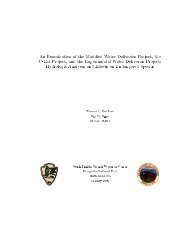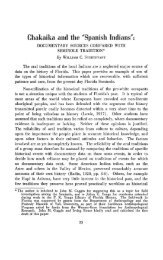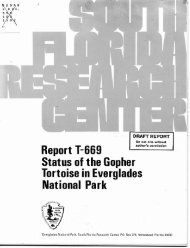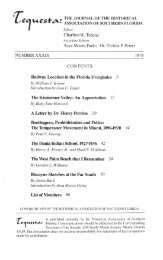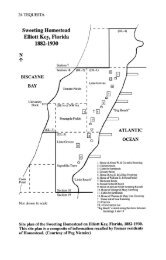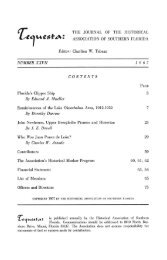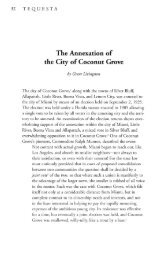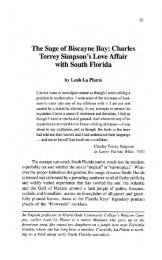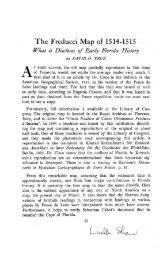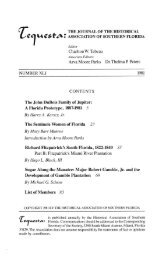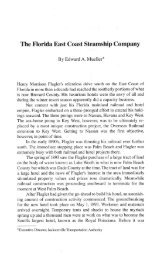Miami During the Civil War - FIU Digital Collections
Miami During the Civil War - FIU Digital Collections
Miami During the Civil War - FIU Digital Collections
You also want an ePaper? Increase the reach of your titles
YUMPU automatically turns print PDFs into web optimized ePapers that Google loves.
<strong>Miami</strong> <strong>During</strong> <strong>the</strong> <strong>Civil</strong> <strong>War</strong> 49<br />
West. He considered <strong>the</strong> lighthouse generally in a good state of preservation<br />
and stated that all materials necessary to repair and relight<br />
<strong>the</strong> apparatuses were on hand at Key West. Bissell also wrote that he<br />
was well acquainted with all <strong>the</strong> settlers in <strong>Miami</strong>. There were only<br />
15 people living <strong>the</strong>re, and <strong>the</strong>y would pose no danger to <strong>the</strong> new<br />
lighthouse keepers, he said. In addition, Bissell argued, "The nearest<br />
settlement. . .is at least 150 miles away and <strong>the</strong> country between<br />
almost impenetrable." 59 Bissell's position was clear; his ties with <strong>Miami</strong><br />
were still strong and <strong>the</strong> relighting would help promote <strong>the</strong> area.<br />
Bissell was correct; by this time replacement lamps, lenses, and<br />
reflectors necessary to put <strong>the</strong> light back in operation had been purchased<br />
by <strong>the</strong> Federal Lighthouse Board and were in storage at Key<br />
West. The reefs bordering Biscayne Bay remained deadly and had<br />
claimed two large Union troopships, <strong>the</strong> Lucinda and <strong>the</strong> Sparkling<br />
Sea during one week in early January 1863. But General Woodbury<br />
had already decided against it. In a letter to <strong>the</strong> Lighthouse Board in<br />
Washington dated May 4, 1863, <strong>the</strong> Army commander reported that<br />
he opposed reestablishment of <strong>the</strong> lighthouse because "<strong>the</strong> existence<br />
of <strong>the</strong> light might tempt evil-disposed persons to come from a distance<br />
to break it up." He thought a small garrison would be needed to<br />
protect it. Ano<strong>the</strong>r problem was that mechanics or day laborers would<br />
be difficult to find. "A light vessel anchored inside <strong>the</strong> reef about one<br />
mile north west of Fowey Rocks would be more useful," wrote <strong>the</strong><br />
General, anticipating <strong>the</strong> establishment of Fowey Rock Lighthouse<br />
that replaced <strong>the</strong> Cape Florida Light in 1878. He also wrote that he<br />
was familiar with <strong>the</strong> area and was unconcerned about "<strong>the</strong> four or<br />
five families living on <strong>the</strong> mainland who were well disposed."<br />
The U.S. Army took no fur<strong>the</strong>r action to restore <strong>the</strong> lighthouse<br />
despite <strong>the</strong> interest of <strong>the</strong> Lighthouse Board in Washington and <strong>the</strong><br />
recommendation of Lieutenant Commander English of <strong>the</strong> Sagamore.<br />
After receiving General Woodbury's letter of May 4th, <strong>the</strong> Lighthouse<br />
Board deferred <strong>the</strong> issue. 60<br />
In contrast to Theodore Bissell who worked for <strong>the</strong> Yankee<br />
government, George Lewis engaged in activities that made <strong>the</strong> federal<br />
authorities strongly suspect him of aiding <strong>the</strong> rebellion. The Army<br />
finally captured him on <strong>the</strong> night of January 7, 1864, at Fort Myers,<br />
an abandoned Seminole <strong>War</strong> fort on <strong>the</strong> west coast of <strong>the</strong> state. Lewis<br />
and two o<strong>the</strong>r men were accused by <strong>the</strong> Union forces of making<br />
preparations to destroy <strong>the</strong> fort to prevent it from falling into Union<br />
hands. One of his companions, a Mr. Griffin, was also a known<br />
blockade runner. 61



